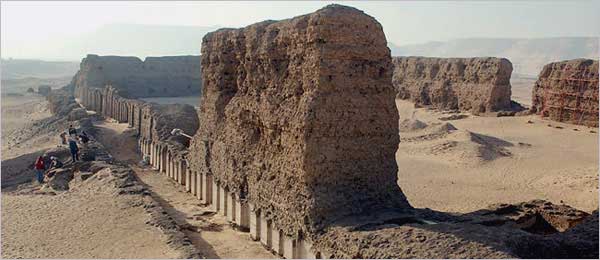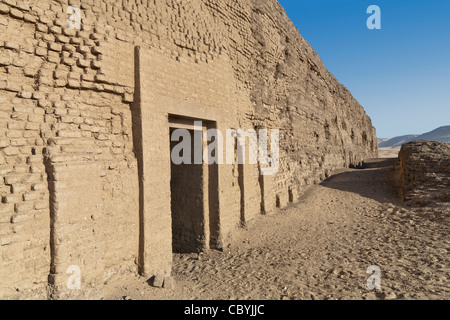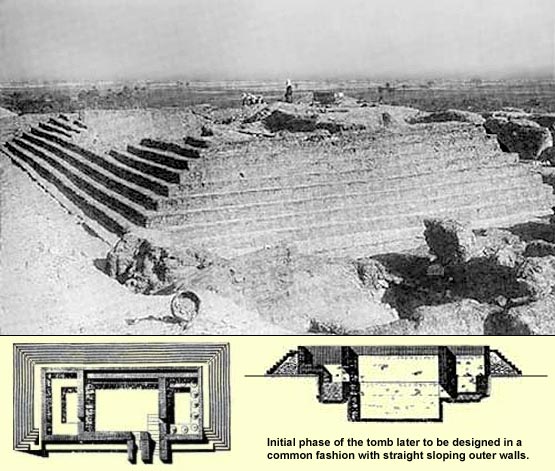Readers will recall written in the Tomb of Debhen (or "Debehen", Central Field: Tomb G 8090) he speaks of Menkaure inspecting work being done on his pyramid "Divine-is-Menkure":
In the Tomb of Debhen is also depicted a truncated pyramid with temple on top:
Figure I.18: Detail of the decoration of wall 5 in the tomb of Debhen (LD, Plates, II, 35;LG 90, PM, III¹, 235-6) on p18.
I Architecture, Decoration and Interpretation
Photo Reference.
Use the +/- to enlarge then hold your mouse on the image to move it around.
Main page.
Astute readers will be instantly reminded of the same kind of structures depicted on 1st Dynasty artifacts such as the Narmer macehead:
![]()
![]()
And various tokens:
![]()
In one of my reference books there is a 1st Dynasty artifact depicting a double stairway, I'll have to dig it out when I have the time, which seems to confirm what I have argued previously that these 1st Dynasty depictions of "half stairways" were shown as only half out of artistic economy and in actuality were full double sided structures. The scene in the Tomb of Debhen I would argue is the same, depicting half of the whole, yet it is interesting to note that the truncated pyramid depicted here is no longer stepped, but rather smooth sided as if it were cased.
Like the palace facade building of the Serekh, the stepped platform, a "stepped pyramid" if you will, is yet another archetypical structure depicted in Egyptian art from the very formation of Dynastic Egypt itself.
1st Dynasty palace facade serekh building (which depictions date back to Dynasty 0/Naqada II):
![]()
![]()
4th Dynasty full depiction:
![]()
2nd Dynasty or earlier:
![]()
![]()
1st Dynasty Tomb 3504 (among numerous others):
![]()
1st Dynasty stepped pyramid/platform (many examples which again date back to Dynasty 0/Naqada II):
![]()
1st Dynasty "stepped pyramid" (Emery) mastaba 3038:
![]()
What we can see is that the Dynastic Egyptians, part and parcel of the formation of the Dynastic state itself, built the very buildings they depicted in their writing and art which included stepped pyramids and massive palace facade buildings like what we see repeated in the serekh, both of which, as an aside, have their origins in Mesopotamia. In the Tomb of Debhen not only do we have testimony of Menkaure working on his pyramid, whatever that may mean, but depicted as is the now smooth sided, like the pyramids of the period, truncated stepped pyramid seen since Dynasty 0. This is but one example from one tomb of which there are hundreds and hundreds of such in the OK that the internet does not provide us with every picture, which there seems little doubt, with effort, there are many more such examples to be had.
Quote
As for this tomb, it was the king of Upper and Lower Egypt, Menkure, [living forever], who caused that it be [made], when [his majesty] was [upon] the road beside the pyramid, HirC (HY), in order to inspect the work on the pyramid: "Divine-is-Menkure." --- [there camel] the [naval] commander and the two high priests of Memphis, and
the [workmen, standing upon it, to inspect the work on [the pyramid, "Divine-is-Menkure"]. - 50 men were assigned to do the work on it every day, besides [exacting of them, that which the r-1 desired. His majesty commanded that [no man
should be taken] for any forced labor, except to do the work on it, to his satisfaction.
In the Tomb of Debhen is also depicted a truncated pyramid with temple on top:
Figure I.18: Detail of the decoration of wall 5 in the tomb of Debhen (LD, Plates, II, 35;LG 90, PM, III¹, 235-6) on p18.
I Architecture, Decoration and Interpretation
Photo Reference.
Use the +/- to enlarge then hold your mouse on the image to move it around.
Main page.
Astute readers will be instantly reminded of the same kind of structures depicted on 1st Dynasty artifacts such as the Narmer macehead:


And various tokens:

In one of my reference books there is a 1st Dynasty artifact depicting a double stairway, I'll have to dig it out when I have the time, which seems to confirm what I have argued previously that these 1st Dynasty depictions of "half stairways" were shown as only half out of artistic economy and in actuality were full double sided structures. The scene in the Tomb of Debhen I would argue is the same, depicting half of the whole, yet it is interesting to note that the truncated pyramid depicted here is no longer stepped, but rather smooth sided as if it were cased.
Like the palace facade building of the Serekh, the stepped platform, a "stepped pyramid" if you will, is yet another archetypical structure depicted in Egyptian art from the very formation of Dynastic Egypt itself.
1st Dynasty palace facade serekh building (which depictions date back to Dynasty 0/Naqada II):


4th Dynasty full depiction:

2nd Dynasty or earlier:


1st Dynasty Tomb 3504 (among numerous others):

1st Dynasty stepped pyramid/platform (many examples which again date back to Dynasty 0/Naqada II):

1st Dynasty "stepped pyramid" (Emery) mastaba 3038:

What we can see is that the Dynastic Egyptians, part and parcel of the formation of the Dynastic state itself, built the very buildings they depicted in their writing and art which included stepped pyramids and massive palace facade buildings like what we see repeated in the serekh, both of which, as an aside, have their origins in Mesopotamia. In the Tomb of Debhen not only do we have testimony of Menkaure working on his pyramid, whatever that may mean, but depicted as is the now smooth sided, like the pyramids of the period, truncated stepped pyramid seen since Dynasty 0. This is but one example from one tomb of which there are hundreds and hundreds of such in the OK that the internet does not provide us with every picture, which there seems little doubt, with effort, there are many more such examples to be had.